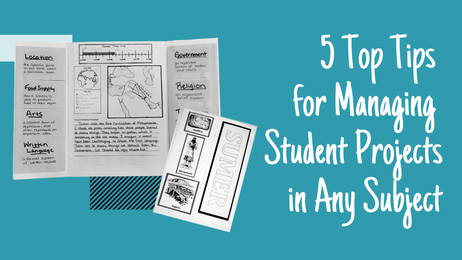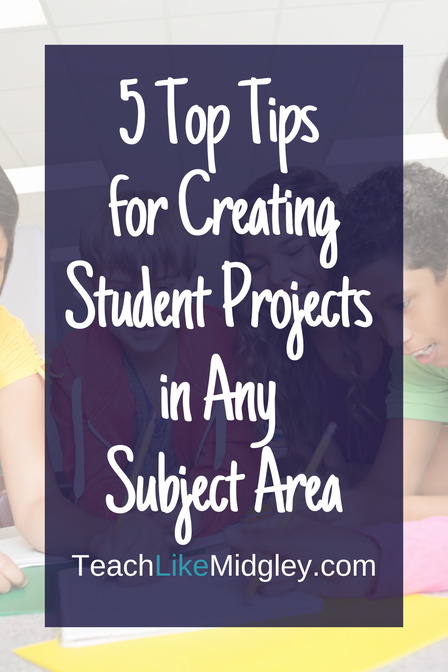5 Top Tips for Creating Student Projects in Any Subject Area
No unit – no matter what the subject – is complete without a good student project.
Maybe it’s a research project.
Maybe it’s a cumulative project.
Maybe it’s a partner, small-group or independent project.
Maybe it’s a research project.
Maybe it’s a cumulative project.
Maybe it’s a partner, small-group or independent project.
We can probably all agree that projects are great – they get kids actively involved in their learning.
And it’s fair to say that some projects are more structured than others.
But no matter how much fun students may have with projects, we must also be on the lookout for the stress that projects can bring students.
Providing clear expectations and structure is a great place to start with supporting students.
By the same token, we can also take the opportunity to teach students how to approach and manage projects themselves, in a successful way.
This post will provide you with some tips to make student projects run a bit more smoothly no matter what grade level or subject you teach.
#1 - Use a Project Guide
No matter what you do – please do not just verbally tell students about their project.
Provide them with the details on paper.
And not just a list of the requirements with a due date. You’ll want to also provide information about access to resources and most importantly, a timeline. This will help students learn valuable time management skills.
Not sure how to do that? Use this Editable Project Template.
Provide them with the details on paper.
And not just a list of the requirements with a due date. You’ll want to also provide information about access to resources and most importantly, a timeline. This will help students learn valuable time management skills.
Not sure how to do that? Use this Editable Project Template.
#2 - Give Verbal & Visual Reminders
Check in with students regularly.
At the start of class, remind them what stage you are at and what’s coming next.
At the end of class, review what was accomplished, what needs to be done possibly for homework, and what’s happening the next day.
A great way to avoid the dreaded questions like “Miss, what’s next?” is to provide visuals that students can reference. You might be thinking – isn’t that the purpose of the Project Guide – but trust me, having a visual will save your sanity more than you know.
An easy way to do this, is to utilize editable Instructional Slides that are simple and effective.
At the start of class, remind them what stage you are at and what’s coming next.
At the end of class, review what was accomplished, what needs to be done possibly for homework, and what’s happening the next day.
A great way to avoid the dreaded questions like “Miss, what’s next?” is to provide visuals that students can reference. You might be thinking – isn’t that the purpose of the Project Guide – but trust me, having a visual will save your sanity more than you know.
An easy way to do this, is to utilize editable Instructional Slides that are simple and effective.
#3 - Teach Research Skills
One big challenge students face is how to find information. A very important skill for research projects.
Before launching into a big research project, consider coordinating with your librarian on conducting some lessons on how to research.
If your schedule doesn’t permit these lessons, then consider providing students with a list of approved sources. It can be as easy as a cart of books from the library and/or a list of websites with quality information.
It would be worth your time to teach your students why these resources are credible.
Before launching into a big research project, consider coordinating with your librarian on conducting some lessons on how to research.
If your schedule doesn’t permit these lessons, then consider providing students with a list of approved sources. It can be as easy as a cart of books from the library and/or a list of websites with quality information.
It would be worth your time to teach your students why these resources are credible.
#4 - Assign Roles & Tasks for Group Projects
If you decide to plan out a group project, then keep these strategies in mind. They will not only save your sanity, but that of your students too.
Give each student in the group an assigned role. And give each role specific tasks.
This ensures one student does not take over the entire project and helps to ensure that everyone does their fair share. Think of it as a jigsaw project.
Give each student in the group an assigned role. And give each role specific tasks.
This ensures one student does not take over the entire project and helps to ensure that everyone does their fair share. Think of it as a jigsaw project.
#5 - Provide an Example Project
Think about your students and their different learning styles.
Some students have no problem following written directions and visualizing for themselves, the end product.
Other students will struggle to understand what they are supposed to do, until they see it modeled for them.
Provide students with examples throughout each step of your project. To prevent students from just copying your example – have it be on a separate topic, but have all the same required pieces.
Here's an example. When I have students complete a comprehensive lap-book project for the different empires of ancient Mesopotamia (Akkad, Babylon, and Assyria), I provided them with an example of the finished project using the first society we studied together: Sumer.
Some students have no problem following written directions and visualizing for themselves, the end product.
Other students will struggle to understand what they are supposed to do, until they see it modeled for them.
Provide students with examples throughout each step of your project. To prevent students from just copying your example – have it be on a separate topic, but have all the same required pieces.
Here's an example. When I have students complete a comprehensive lap-book project for the different empires of ancient Mesopotamia (Akkad, Babylon, and Assyria), I provided them with an example of the finished project using the first society we studied together: Sumer.
Ready to Roll Materials
Remember that no matter what subject area you teach – mathematics, history, science, English language arts, health, computer class, or any elective for that matter – teaching study skills alongside your content will go a long way in helping your students find success.
This is more important than ever at the secondary level.
Many secondary teachers assume students already have these skills, but many students do not.
You can incorporate study skills into your lessons easier than you think – check out my training for teachers:
Study Skills Integration Training for Teachers - Professional Development
This is more important than ever at the secondary level.
Many secondary teachers assume students already have these skills, but many students do not.
You can incorporate study skills into your lessons easier than you think – check out my training for teachers:
Study Skills Integration Training for Teachers - Professional Development
You Might Also Like...
Let's Connect...

Welcome! I'm Hillary Midgley, a veteran 6th grade teacher.
I create educational materials and develop curriculum for other teachers. I specialize in teaching students how to learn through my Study Skills Curriculum. I have established fundamental classroom systems and structures for teachers to help them streamline their classroom. And my passion is teaching ancient history through engaging activities with foundations in academic skills. Here you will find resources on all of these topics and more. Learn more about me here.
|






